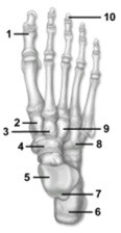A) 2
B) 4
C) 5
D) 8
E) 9
Correct Answer

verified
Correct Answer
verified
Multiple Choice
The part of a rib that articulates with the demifacets on the bodies of vertebrae is the
A) head.
B) tubercle.
C) shaft.
D) tuberosity.
Correct Answer

verified
Correct Answer
verified
Multiple Choice
Which bone is not part of the axial skeleton?
A) Malleus
B) Sacrum
C) Clavicle
D) Atlas
E) Frontal bone
Correct Answer

verified
Correct Answer
verified
Multiple Choice
What is the location of the auditory ossicles?
A) Petrous part of temporal bone
B) Squamous part of temporal bone
C) Tympanic part of temporal bone
D) Auditory part of temporal bone
E) Mastoid part of temporal bone
Correct Answer

verified
Correct Answer
verified
Multiple Choice
The pterygoid spines and optic canals are features of the ________ bone.
A) ethmoid
B) temporal
C) sphenoid
D) occipital
E) frontal
Correct Answer

verified
Correct Answer
verified
Multiple Choice
What bone(s) does the clavicle articulate with?
A) Scapula only
B) Scapula and sternum
C) Scapula and humerus
D) Humerus and sternum
E) Humerus only
Correct Answer

verified
Correct Answer
verified
Multiple Choice
Which cranial fossa supports the cerebellum?
A) Anterior
B) Posterior
C) Middle
D) Lateral
E) Medial
Correct Answer

verified
Correct Answer
verified
Multiple Choice
Which is not correct regarding the femur?
A) The condyles are located at the distal end of the bone.
B) In anatomic position, the femur is angled medially.
C) The head of the femur articulates with the acetabulum.
D) The intercondylar fossa is located on the anterior surface of the bone.
E) The depression in the head of the femur is called the fovea.
Correct Answer

verified
Correct Answer
verified
Multiple Choice
 -This figure shows the bones of the ankle and foot. What view is shown?
-This figure shows the bones of the ankle and foot. What view is shown?
A) Inferior view of left ankle and foot
B) Superior view of left ankle and foot
C) Superior view of right ankle and foot
D) Ventral view of right ankle and foot
E) Lateral view of right ankle and foot
Correct Answer

verified
Correct Answer
verified
Multiple Choice
The sagittal suture joins the
A) left and right parietal bones.
B) left and right temporal bones.
C) parietal and occipital bones.
D) temporal and occipital bones.
E) frontal and parietal bones.
Correct Answer

verified
Correct Answer
verified
Multiple Choice
The bones of the antebrachium are the
A) radius, ulna, and humerus.
B) radius, ulna, humerus, and carpals.
C) radius, ulna, carpals, and metacarpals.
D) radius and ulna.
E) carpals, metacarpals, and phalanges.
Correct Answer

verified
Correct Answer
verified
Multiple Choice
 -This figure shows the humerus. What is the feature indicated by number 6?
-This figure shows the humerus. What is the feature indicated by number 6?
A) Capitulum
B) Trochlea
C) Head
D) Medial condyle
E) Lateral condyle
Correct Answer

verified
Correct Answer
verified
Multiple Choice
The occipital condyles articulate with the
A) axis.
B) atlas.
C) dens.
D) vertebra prominens.
E) odontoid process.
Correct Answer

verified
Correct Answer
verified
Multiple Choice
What is the function of the nuchal lines?
A) Attachment for dura mater
B) Attachment for muscles and ligaments
C) Passageway for cranial nerves
D) Passageway for jugular vein
E) Grooves for dural sinuses
Correct Answer

verified
Correct Answer
verified
Short Answer
Each vertebral arch is composed of two pedicles and two ________.
Correct Answer

verified
Correct Answer
verified
Multiple Choice
Which is a sesamoid bone?
A) Femur
B) Patella
C) First metatarsal
D) Clavicle
E) Calcaneus
Correct Answer

verified
Correct Answer
verified
Multiple Choice
The biceps brachii muscle attaches to the ________ of the radius.
A) neck
B) radial tuberosity
C) styloid process
D) head
E) radial notch
Correct Answer

verified
Correct Answer
verified
Multiple Choice
What is the function of the cribriform plate?
A) Permits air to enter the cranial cavity to cool the brain
B) Provides large surface area for muscle attachment
C) Permits passage of the olfactory nerves
D) Forms part of the nasal septum
E) Articulates with the atlas for rotational head movement
Correct Answer

verified
Correct Answer
verified
Multiple Choice
Which feature is unique to the axis?
A) Dens
B) Bifid spinous process
C) Superior articular facet
D) Transverse foramen
E) Vertebral foramen
Correct Answer

verified
Correct Answer
verified
Short Answer
The three bones that make up each of the ox coxae are the ilium, pubis, and ________.
Correct Answer

verified
Correct Answer
verified
Showing 121 - 140 of 203
Related Exams